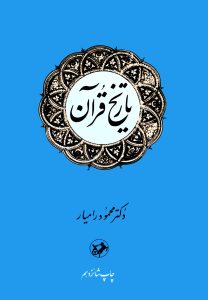Mahmood Ramiyar, Tārikh-i Qurʼān [History of the Quran], 1346 Sh/ 1967, Tehran: Amir Kabir, 1362 Sh/ 1993. 823 pp.
This is a comprehensive outline history of the Holy Quran. The author, Dr. Mahmood Ramiyar (1301-1363 Sh/ 1922-1984), was a prolific Iranian academic of Mashhad. An eminent graduate of both the university and traditional hawzahs of Mashhad and Tehran, his book has proved a noteworthy single-volume compendium and outline history of the Holy Quran; it has received subsequent reprint editions, too.
The book under review starts with the author’s humble apology before the sublime status of the Holy Quran, the intact Divine Book. The text indicates the author’s sense of respect and humility in attempting to develop a history of the Divine Book.
The book then turns to the title and various names of the Holy Quran. This is evident in the Holy Quran itself. It refers to itself by means of other designations and titles, hence a suitable endeavor to provide the reader with various names and designations of the Holy Quran. In doing so, it explains the etymological meanings of the names cited in the Holy Quran. This is followed by a sketch background of the Prophet Muhammad’s frequent retreats to other cozy places for religious meditations before his receiving the earliest instances of the Divine revelation.

As the Divine revelation (al-waḥy) has been the means of receiving the Holy Quran, two chapters are devoted to it. In Chapter 4, various types of the Divine revelation are explained, and Chapter 5 takes the reader to elucidations of the nature of the Divine revelation from lexical, historical, and hadith perspectives. The book then deals with the descent, times, duration, places, and manners of the Prophet’s reception of the Holy Quran.
Collection and preservation of the Holy Quran makes the theme of the seventh chapter of the book. In it, the reader finds that the Prophet himself was keen on recording down the pieces of the revelation that he used to receive. This is never in contradistinction with the Prophet’s having several reliable scribes of the Holy Quran. Although the Meccan period of the life of the Prophet was a time of psycho-social pressure on Muslims, the Prophet was keen to dictate the piece of the Holy Quran he used to receive in the form of the Divine revelation. In contrast to the Meccan period, the Medina phase of his life was much easier and more comfortable, hence he had more scribes.
It has been a hot topic as to who collected the Holy Quran in its canonical form. This is the topic being dealt with in Chapters 8-11. In these chapters, the reader finds the fate of the Holy Quran in the time of the three rulers who declared themselves the successors to the Prophet. The last section of Chapter 11 turns to certain personalized collections of the Quranic suras that some of the companions of the Prophet kept for and with themselves. The concluding discourse of this chapter deals with the codex (muṣḥaf) that the sixth Infallible Imam Jaʻfar al-Ṣādiq kept with himself.
Since the script of all languages are subject to gradual change, the Arabic language was no exception throughout its history. However, the significance and sublimity of the Holy Quran have since necessitated it that its text must be recorded in a clear, unambiguous manner so that all Muslims would find it easy to read. This orthographical development and change and various alphabets adopted to suit the script of the Holy Quran come in the twelfth chapter of the book. Because Arabic is a Semitic language wherein short vowels are oftentimes not indicated, the words of the Holy Quran were subject to being misread, particularly by non-Arab Muslims. To overcome this problem, various diacritical marks have come into use.
Readers find structural divisions of the Holy Quran in Chapter 14 of the book. Here various sections and sub-sections of the Holy Quran are introduced and explained. This is followed by a survey of the order of the Quranic suras, too.
The Quranic text is often divided into Meccan and Medinan suras. This is a rough classification that alludes to the place where a certain piece was revealed unto the Prophet. Other finer classifications have also been made. Not only Muslims but also non-Muslim Orientalists have catalogued the Quranic verses and suras into various ways. There points made the subject of Chapter 15 of the book.
The occasions of the revelation of the Holy Quran appear in Chapter 16 of the book. In it, the reader finds various uses and ways to identify where and when certain verses were revealed unto the Prophet.

The final chapter of the book deals with the critical topic of Quran translation. As translation of sacred texts make a separate and distinguished topic in its own right, what makes Quran translation distinct from other sacred texts is its purely Divine nature and texture. However divinely it might claim, no other sacred text matches the Holy Quran in terms of being intactly and purely Divine in character. As such, its translation is no easy task to be carried out by any lay person.
The book has several supplements in lieu of various short chapters to be added to the book. Apart from them, various useful indexes provide the readers with quick references to the contents of the book. The last ten pages of the book are devoted to earliest manuscripts of the Holy Quran.
Since this book draws upon Shii, Sunni, and Western sources, it deserves translation into other languages, too.
